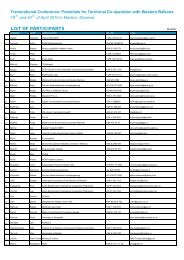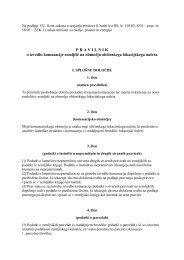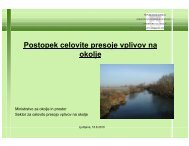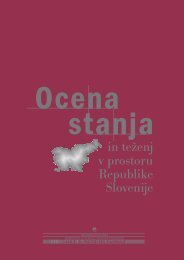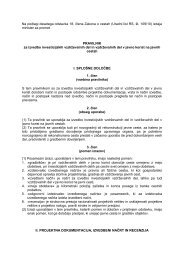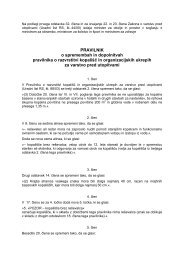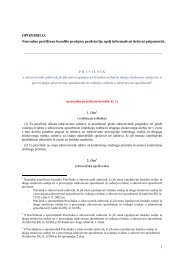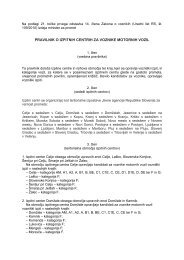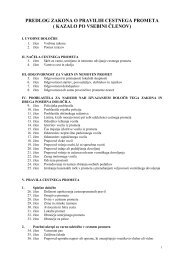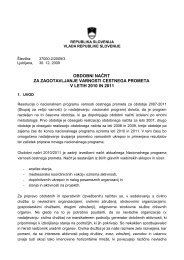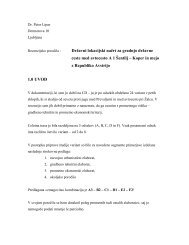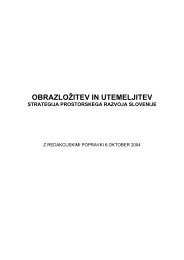evropska konvencija o krajini - Ministrstvo za infrastrukturo in prostor
evropska konvencija o krajini - Ministrstvo za infrastrukturo in prostor
evropska konvencija o krajini - Ministrstvo za infrastrukturo in prostor
You also want an ePaper? Increase the reach of your titles
YUMPU automatically turns print PDFs into web optimized ePapers that Google loves.
162Delavnica 2 / Workshop 2podeželjskih območij. Z gozdno-gospodarskim<strong>in</strong>ačrti načrtujemo ekonomsko, socialno <strong>in</strong>biotsko funkcijo gozdnih kraj<strong>in</strong> v njenemupravljalskem delu, medtem ko je raba <strong>za</strong> gozdže <strong>za</strong>jeta v <strong>prostor</strong>skem planu.Dosedanje izkušnja kažejo na to, da so v vsehplanih upoštevani relevantni vidiki okoljskihciljev <strong>in</strong> da je v več<strong>in</strong>i primerov okoljskih poročilpoleg vseh naštetih segmentov obravnavanatudi kraj<strong>in</strong>a kot posebno poglavje.10. ZaključekNa podlagi primerov izvajanja celovitih presoj vSloveniji lahko <strong>za</strong>ključimo, da je ta horizontalni<strong>in</strong>strument pomemben <strong>za</strong> vkjučevanje kraj<strong>in</strong>e vdružbeno odločanje.Pri tem pa poudarjamo upoštevanje nekajnajpomembnejših načel, ki so temelj <strong>za</strong> uspešenproces vključevanja kraj<strong>in</strong>e v plane <strong>in</strong> programepri celoviti presoji vplivov na okolje:10. 1. Načelo <strong>in</strong>tegralnega pristopa– z uvajanjem okoljskih vidikov v plan <strong>in</strong>okoljskim poročilom se prične takoj oz.čimprej, ko se se pristopi k izdelavi plana;– stroka mora aktivno sodelovati ter na področjuizobraževanja <strong>za</strong>gotoviti takšno ravenpraktičnega znanja, da je vključitev v procesemožna;10. 2. Načelo sodelovanja <strong>in</strong> medsebojnegaupoštevanja– stroka obvlada metode vključevanja javnosti<strong>in</strong> postane odprta <strong>za</strong> širšo strokovno javnost,še posebej je to priporočljivo v fazi opredeljevanjaokoljskih ciljev;– izdelovalci plana <strong>in</strong> okoljskega poročila morajoimeti obveznost sodelovanja <strong>in</strong> morajo biti<strong>za</strong> to strokovno usposobljeni,– priporočena je sočasna javna razgrnitev alirazgrnitev z m<strong>in</strong>imalnim časovnim <strong>za</strong>mikom;10. 3. Načelo strokovne odličnosti <strong>in</strong>transparentnosti– okoljsko poročilo mora biti skladno s predpisi<strong>in</strong> strokovno odlično, saj mora podajati tudipredloge <strong>za</strong> izboljšavo planov/programov,– izsledki priprav/okoljskega poročila morajobiti <strong>za</strong>jeti v plan na čimvišji kakovostni ravni,Assessment is l<strong>in</strong>ked to all environmental segments.The goals of reach<strong>in</strong>g a favourable qualityof ground and underground waters must be<strong>in</strong>cluded <strong>in</strong> the draft<strong>in</strong>g of the plan as flow<strong>in</strong>gwater presents an important landscape elementthat also def<strong>in</strong>es the use alongside rivers andstreams. The assessment is also bound to thegoals of preserv<strong>in</strong>g valuable natural features andbiotic diversity, an important segment of environmentaldiversity. We would also like to draw theattention to the Natura 2000 European ecologicalnetwork, which protects the structure andthe landscape diversification and also envisagesf<strong>in</strong>ancial mechanisms. The assessment mustresult <strong>in</strong> a solution that reta<strong>in</strong>s the areas anddoes not have a major impact on the species ortypes of habitat, which the areas are <strong>in</strong>tendedfor. In the case of the Karst, the Natura 2000means dry Karst grasslands, and importantcaves, <strong>in</strong> short, the landscape’s prom<strong>in</strong>ent features.Preserv<strong>in</strong>g characteristic villages and their ma<strong>in</strong>tenancemeanwhile follows the goal of recognisability.Furthermore, the assessment is also l<strong>in</strong>ked tothe goal of secur<strong>in</strong>g health, where the landscapewith its social function plays an important role.In Slovenia, the forest landscape spreads over67% of the country’s surface, while Alp<strong>in</strong>e landscapecovers 33%. Forest landscape at theheight above 800 metres (9% of Slovenian territory)presents an especially important part ofthe landscape. City dwellers on the other handneed green spaces <strong>in</strong> cities to ma<strong>in</strong>ta<strong>in</strong> theirhealth and city landscapes <strong>in</strong> a wider sense thatstimulate and <strong>in</strong>fluence them <strong>in</strong> a positive mannerthrough their diverse functions. The aspectof prevention is especially important.The environmental report therefore has to conta<strong>in</strong>the aims of a quality landscape for each <strong>in</strong>dividuallandscape. Article 1 (c) of the LandscapeConvention is important for strategic assessmentas its »Landscape quality objective«means, for a specific landscape, the formulationby the competent public authorities of the aspirationsof the public with regard to the landscapefeatures of their surround<strong>in</strong>gs.A different attitude goes for the goals, def<strong>in</strong>edon the basis of legislation. I would like to mentioncultural heritage, def<strong>in</strong>ed as a heritage cat-



